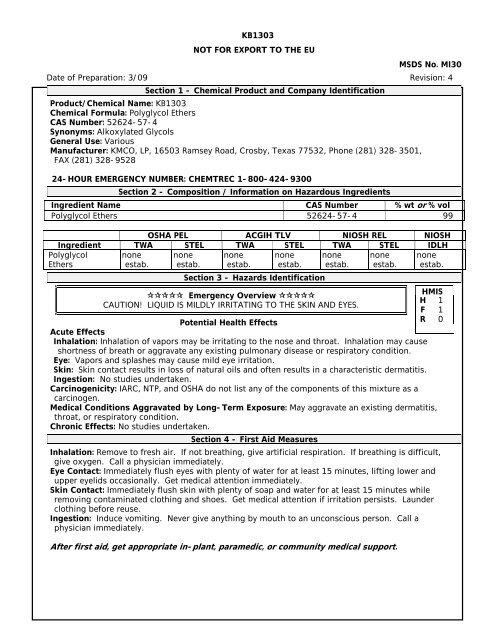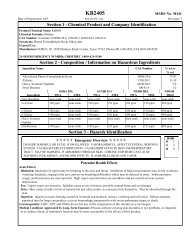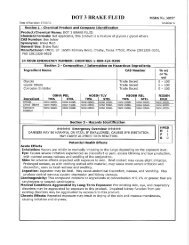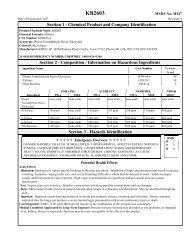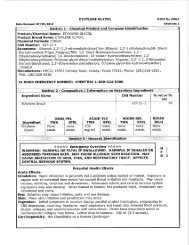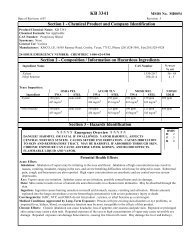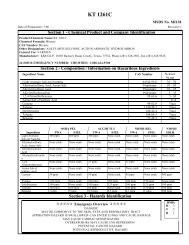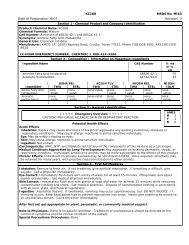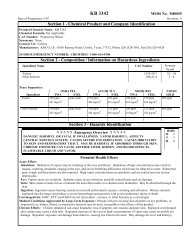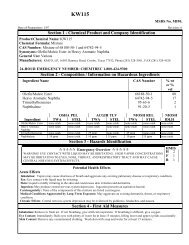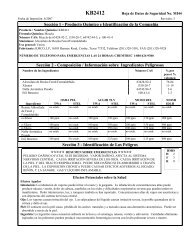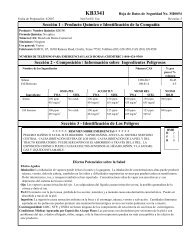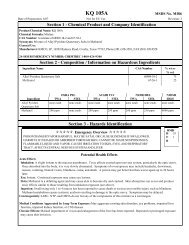KB1303 NOT FOR EXPORT TO THE EU MSDS No. MI30 ... - KMCO
KB1303 NOT FOR EXPORT TO THE EU MSDS No. MI30 ... - KMCO
KB1303 NOT FOR EXPORT TO THE EU MSDS No. MI30 ... - KMCO
Create successful ePaper yourself
Turn your PDF publications into a flip-book with our unique Google optimized e-Paper software.
<strong>KB1303</strong><br />
<strong>NOT</strong> <strong>FOR</strong> <strong>EXPORT</strong> <strong>TO</strong> <strong>THE</strong> <strong>EU</strong><br />
<strong>MSDS</strong> <strong>No</strong>. <strong>MI30</strong><br />
Date of Preparation: 3/09 Revision: 4<br />
Section 1 - Chemical Product and Company Identification<br />
Product/Chemical Name: <strong>KB1303</strong><br />
Chemical Formula: Polyglycol Ethers<br />
CAS Number: 52624-57-4<br />
Synonyms: Alkoxylated Glycols<br />
General Use: Various<br />
Manufacturer: <strong>KMCO</strong>, LP, 16503 Ramsey Road, Crosby, Texas 77532, Phone (281) 328-3501,<br />
FAX (281) 328-9528<br />
24-HOUR EMERGENCY NUMBER: CHEMTREC 1-800-424-9300<br />
Section 2 - Composition / Information on Hazardous Ingredients<br />
Ingredient Name CAS Number % wt or % vol<br />
Polyglycol Ethers 52624-57-4 99<br />
OSHA PEL ACGIH TLV NIOSH REL NIOSH<br />
Ingredient TWA STEL TWA STEL TWA STEL IDLH<br />
Polyglycol<br />
Ethers<br />
none<br />
estab.<br />
none<br />
estab.<br />
none<br />
estab.<br />
none<br />
estab.<br />
none<br />
estab.<br />
none<br />
estab.<br />
none<br />
estab.<br />
Section 3 - Hazards Identification<br />
Emergency Overview <br />
CAUTION! LIQUID IS MILDLY IRRITATING <strong>TO</strong> <strong>THE</strong> SKIN AND EYES.<br />
Potential Health Effects<br />
Acute Effects<br />
Inhalation: Inhalation of vapors may be irritating to the nose and throat. Inhalation may cause<br />
shortness of breath or aggravate any existing pulmonary disease or respiratory condition.<br />
Eye: Vapors and splashes may cause mild eye irritation.<br />
Skin: Skin contact results in loss of natural oils and often results in a characteristic dermatitis.<br />
Ingestion: <strong>No</strong> studies undertaken.<br />
Carcinogenicity: IARC, NTP, and OSHA do not list any of the components of this mixture as a<br />
carcinogen.<br />
Medical Conditions Aggravated by Long-Term Exposure: May aggravate an existing dermatitis,<br />
throat, or respiratory condition.<br />
Chronic Effects: <strong>No</strong> studies undertaken.<br />
Section 4 - First Aid Measures<br />
Inhalation: Remove to fresh air. If not breathing, give artificial respiration. If breathing is difficult,<br />
give oxygen. Call a physician immediately.<br />
Eye Contact: Immediately flush eyes with plenty of water for at least 15 minutes, lifting lower and<br />
upper eyelids occasionally. Get medical attention immediately.<br />
Skin Contact: Immediately flush skin with plenty of soap and water for at least 15 minutes while<br />
removing contaminated clothing and shoes. Get medical attention if irritation persists. Launder<br />
clothing before reuse.<br />
Ingestion: Induce vomiting. Never give anything by mouth to an unconscious person. Call a<br />
physician immediately.<br />
After first aid, get appropriate in-plant, paramedic, or community medical support.<br />
HMIS<br />
1<br />
1<br />
0<br />
H<br />
F<br />
R
Revision: 4 <strong>KB1303</strong> Issue Date: 3/09<br />
<strong>No</strong>te to Physicians: There is no specific antidote. Treatment of overexposure should be directed at<br />
the control of symptoms and the clinical condition of the patient.<br />
Special Precautions/Procedures: <strong>No</strong>ne.<br />
Section 5 - Fire-Fighting Measures<br />
Flash Point: >200 °F (>93.3 °C)<br />
NFPA<br />
Flash Point Method: CC<br />
Burning Rate: <strong>No</strong>t Determined<br />
1<br />
Autoignition Temperature: <strong>No</strong>t Determined<br />
1 0<br />
LEL: <strong>No</strong>t Determined<br />
—<br />
UEL: <strong>No</strong>t Determined<br />
Flammability Classification: Will burn if exposed to heat or flames.<br />
Extinguishing Media: Dry chemical, foam or carbon dioxide. Water spray may be used to keep fire<br />
exposed containers cool, dilute spills to nonflammable mixtures, protect personnel attempting to<br />
stop leak, and disperse vapors.<br />
Unusual Fire or Explosion Hazards: Contact with strong oxidizers may cause fire. Sealed containers<br />
may rupture when heated.<br />
Hazardous Combustion Products: Carbon monoxide, carbon dioxide, and unidentified organic<br />
compounds.<br />
Fire-Fighting Instructions: Do not use direct water stream to extinguish fires. Product may travel<br />
with water and reignite. Do not release runoff from fire control methods to sewers or waterways.<br />
Fire-Fighting Equipment: Because fire may produce toxic thermal decomposition products, wear a<br />
self-contained breathing apparatus (SCBA) with a full facepiece operated in pressure-demand or<br />
positive-pressure mode. Wear full protective clothing.<br />
Section 6 - Accidental Release Measures<br />
Spill /Leak Procedures: Ventilate area of leak or spill. Remove all sources of ignition. Wear<br />
appropriate personal protective equipment. Isolate hazard area. Keep unnecessary and unprotected<br />
personnel from entering. Use non-sparking tools and equipment. Do not flush to sewer.<br />
Small Spills: Contain and recover liquid when possible. Collect liquid in an appropriate container or<br />
absorb with an inert material (e.g. vermiculite, dry sand), and place in a chemical waste container.<br />
Do not use combustible materials, such as sawdust.<br />
Large Spills<br />
Containment: Wear respirator and protective clothing as appropriate. Shut off source of leak if safe<br />
to do so. For large spills, dike far ahead of liquid spill for later disposal. Do not release into sewers<br />
or waterways.<br />
Cleanup: Contain and recover liquid when possible. Collect liquid in appropriate container. Absorb<br />
residue with an inert material. Consult with your environmental department for detailed clean up<br />
instructions.<br />
Regulatory Requirements: Follow applicable OSHA regulations (29 CFR 1910.120).<br />
Section 7 - Handling and Storage<br />
Handling Precautions: Protect against physical damage. Handle material in a well-ventilated area to<br />
minimize potential exposure hazard.<br />
Storage Requirements: Store out of direct sunlight in a cool, well-ventilated area. Separate from<br />
incompatibles.<br />
Regulatory Requirements: This product contains the following chemical(s) subject to the reporting<br />
requirements of SARA Title III Section 311, 312, and 313: none.<br />
Section 8 - Exposure Controls / Personal Protection<br />
Engineering Controls: Controls should be such that adequate ventilation is provided.<br />
Ventilation: Provide general or local exhaust ventilation systems to maintain airborne concentrations<br />
below OSHA PELs (Sec. 2). Local exhaust ventilation is preferred because it prevents contaminant<br />
dispersion into the work area by controlling it at its source.<br />
Administrative Controls: <strong>No</strong>rmal industrial requirements should be in place.<br />
Page 2 of 5
Revision: 4 <strong>KB1303</strong> Issue Date: 3/09<br />
Respiratory Protection: Seek professional advice prior to respirator selection and use. Follow OSHA<br />
respirator regulations (29 CFR 1910.134) and, if necessary, wear a MSHA/NIOSH-approved<br />
respirator. Select respirator based on its suitability to provide adequate worker protection for given<br />
working conditions, level of airborne contamination, and presence of sufficient oxygen. For<br />
emergency or nonroutine operations (cleaning spills, reactor vessels, or storage tanks), wear an<br />
SCBA. Warning! Air-purifying respirators do not protect workers in oxygen-deficient atmospheres. If<br />
respirators are used, OSHA requires a written respiratory protection program that includes at least:<br />
medical certification, training, fit-testing, periodic environmental monitoring, maintenance,<br />
inspection, cleaning, and convenient, sanitary storage areas.<br />
Protective Clothing/Equipment: Wear chemically protective gloves, boots, aprons, and gauntlets to<br />
prevent prolonged or repeated skin contact. Wear protective eyeglasses or chemical safety goggles,<br />
per OSHA eye- and face-protection regulations (29 CFR 1910.133). Contact lenses are not eye<br />
protective devices. Appropriate eye protection must be worn instead of, or in conjunction with<br />
contact lenses.<br />
Safety Stations: Make emergency eyewash stations, safety/quick-drench showers, and washing<br />
facilities available in work area.<br />
Contaminated Equipment: Separate contaminated work clothes from street clothes. Launder before<br />
reuse. Remove this material from your shoes and clean personal protective equipment.<br />
Comments: Never eat, drink, or smoke in work areas. Practice good personal hygiene after using this<br />
material, especially before eating, drinking, smoking, using the toilet, or applying cosmetics.<br />
Physical State: Solid<br />
Appearance and Odor: Light colored paste at<br />
ambient temperature with ether type odor.<br />
Odor Threshold: <strong>No</strong>t Determined<br />
Vapor Pressure: <strong>No</strong>t Determined<br />
Vapor Density (Air=1): >1<br />
Formula Weight: mixture<br />
Density: 9.16 lb/gal<br />
Specific Gravity (H2O=1, at 4 °C): 1.10<br />
pH: 5 - 8<br />
Section 9 - Physical and Chemical Properties<br />
Water Solubility: Insoluble<br />
Other Solubilities: <strong>No</strong>t Available<br />
Boiling Point: <strong>No</strong>t Determined<br />
Freezing/Melting Point: 82°F (27.8°C)<br />
Viscosity: <strong>No</strong>t Determined<br />
Refractive Index: <strong>No</strong>t Determined<br />
Surface Tension: <strong>No</strong>t Determined<br />
% Volatile: <strong>No</strong>t Determined<br />
Evaporation Rate(BuAc=1):
Revision: 4 <strong>KB1303</strong> Issue Date: 3/09<br />
Environmental Degradation: Data not available.<br />
Soil Absorption/Mobility: Data not available.<br />
Section 13 - Disposal Considerations<br />
Whatever cannot be saved for recovery or recycling should be disposed of in an approved waste<br />
facility, in accordance with Federal, State/Provincial and Local requirements.<br />
Shipping Name: <strong>KB1303</strong><br />
Shipping Symbols: N/A<br />
Hazard Class: <strong>No</strong>nhazardous<br />
liquid<br />
ID <strong>No</strong>.: N/A<br />
Packing Group: N/A<br />
Label: N/A<br />
Special Provisions<br />
(172.102): <strong>No</strong>ne<br />
Section 14 - Transport Information<br />
DOT Transportation Data (49 CFR 172.101):<br />
Packaging Authorizations<br />
a) Exceptions: N/A<br />
b) <strong>No</strong>n-bulk Packaging:<br />
N/A<br />
c) Bulk Packaging: N/A<br />
Section 15 - Regulatory Information<br />
Quantity Limitations<br />
a) Passenger, Aircraft, or Railcar: no<br />
limit<br />
b) Cargo Aircraft Only: no limit<br />
Vessel Stowage Requirements<br />
a) Vessel Stowage: <strong>No</strong>ne<br />
b) Other: <strong>No</strong>ne<br />
<strong>EU</strong> REACh – <strong>NOT</strong> REGISTERED AND CAN<strong>NOT</strong> BE <strong>EXPORT</strong>ED IN<strong>TO</strong> <strong>THE</strong> <strong>EU</strong>.<br />
EPA Regulations:<br />
RCRA Hazardous Waste Number: (40 CFR 261.33): none<br />
RCRA Hazardous Waste Classification (40 CFR 261.): none<br />
CERCLA Hazardous Substance (40 CFR 302.4) not listed specific per RCRA, Sec. 3001; CWA,<br />
Sec. 311 (b)(4); CWA, Sec. 307(a), CAA, Sec. 112<br />
CERCLA Reportable Quantity (RQ), none<br />
SARA 311/312 (40 CFR 370) Codes: none<br />
SARA 313 Toxic Chemical (40 CFR 372.65): not listed<br />
SARA 304 EHS (Extremely Hazardous Substance) (40 CFR 355): not listed<br />
OSHA Regulations:<br />
Air Contaminant (29 CFR 1910.1000, Table Z-1, Z-1-A): <strong>No</strong>t listed<br />
OSHA Specifically Regulated Substance (29CFR 1910): <strong>No</strong>t listed<br />
California Proposition 65 ingredients:<br />
<strong>No</strong>ne<br />
Section 16 - Other Information<br />
Prepared By: <strong>KMCO</strong>, LP<br />
Revision <strong>No</strong>tes: All sections revised as part of conversion to 16 Section format.<br />
Additional Hazard Rating Systems: <strong>No</strong>ne.<br />
Disclaimer: This product is <strong>FOR</strong> INDUSTRIAL USE ONLY. KEEP OUT OF REACH OF CHILDREN. DO<br />
<strong>NOT</strong> TAKE INTERNALLY.<br />
<strong>KMCO</strong>, LP believes that the information and recommendations contained herein (including data and<br />
statements) are accurate as<br />
of the date hereof. <strong>No</strong> warranty of fitness for any particular purpose, warranty of merchantability, or<br />
any other warranty<br />
expressed or implied, is made concerning the information provided herein. The information provided<br />
herein relates only to the<br />
specific product designated and may not be valid where such product is used in combination with any<br />
other materials or in any<br />
process. Further, since the conditions and methods of use of the product and of the information<br />
referred to herein are beyond the<br />
control of <strong>KMCO</strong>, LP, <strong>KMCO</strong>, LP expressly disclaims any and all liability as to any results obtained or<br />
arising from any use of<br />
the product or reliance on such information.<br />
Page 4 of 5
Revision: 4 <strong>KB1303</strong> Issue Date: 3/09<br />
For additional product information, please contact the <strong>KMCO</strong>, LP, Sales Office at 281-272-4100.<br />
Page 5 of 5


